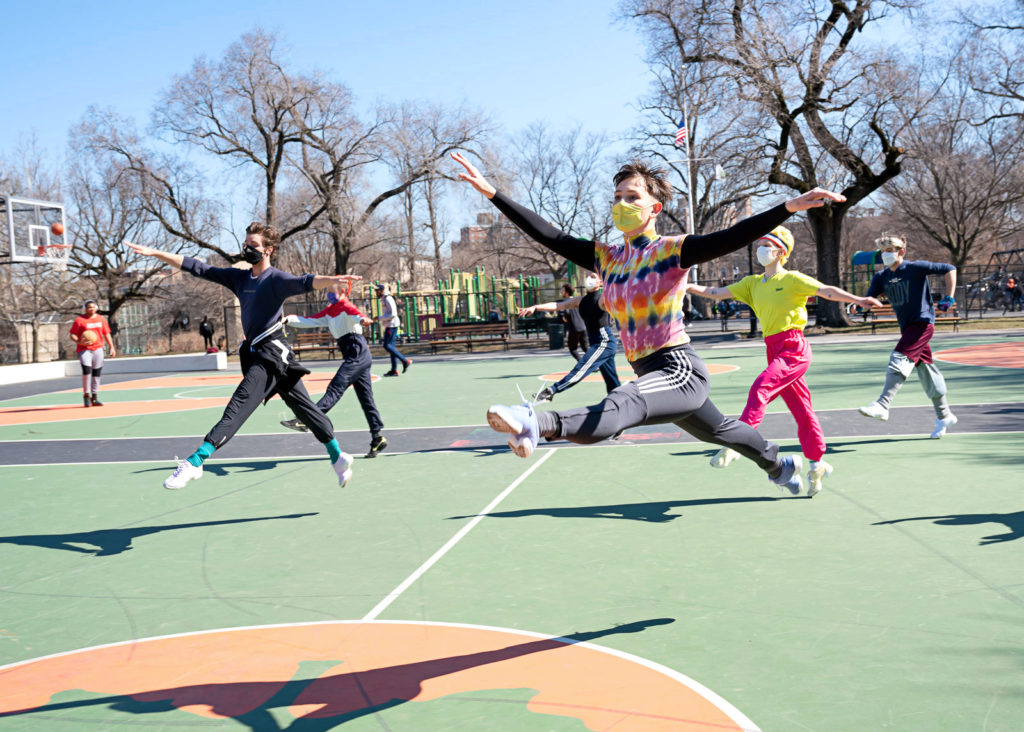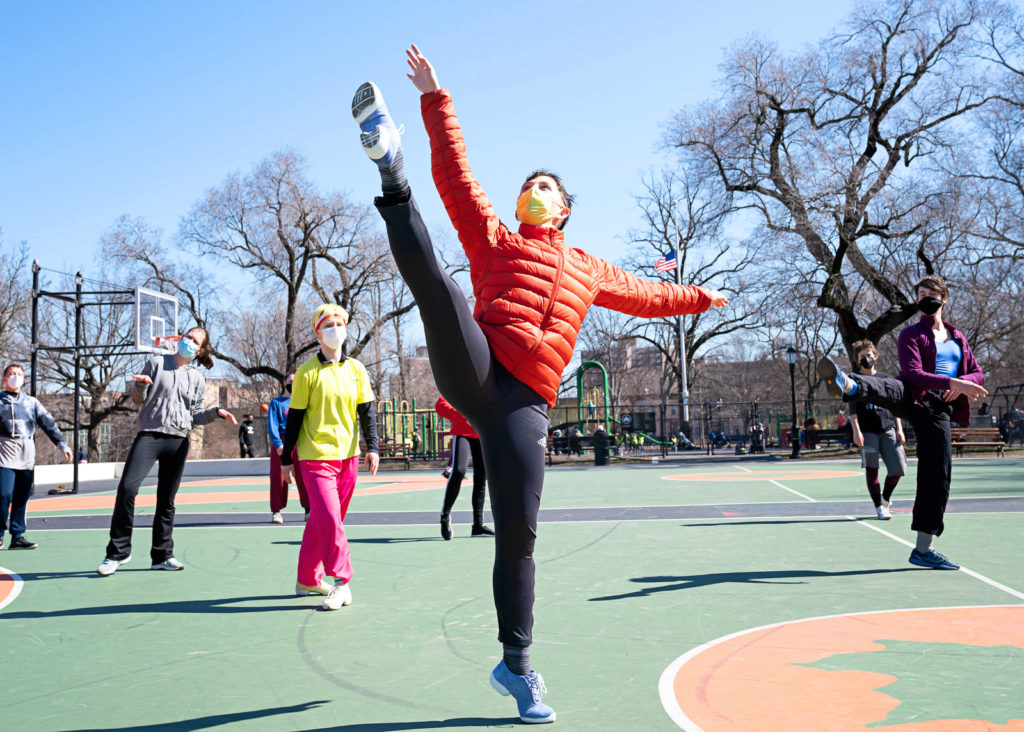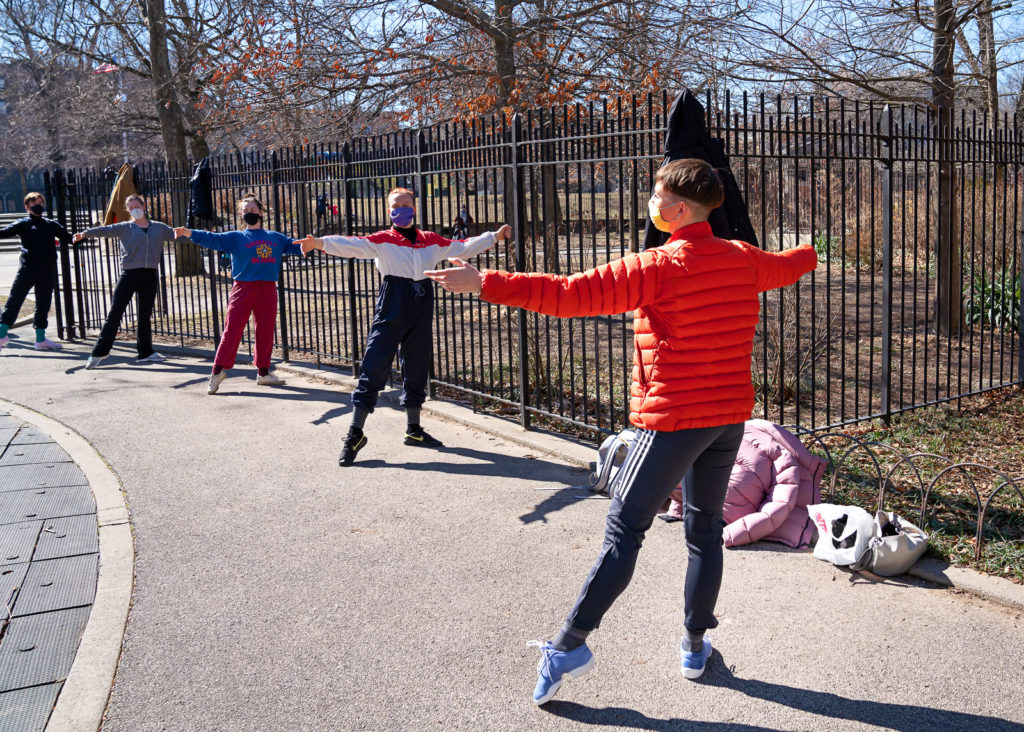
For Ballez founder Katy Pyle, the pun came first and the epiphany second. “In 2011, I was having a conversation with a group of other queer, female-assigned contemporary dancers,” Pyle remembers, “and the consensus was that we all missed ballet, but we would never go back into that world. I realized how messed up it was that we felt no agency within the situation, and I decided that I wanted to have power over ballet—not the other way around.”
Pyle, who went on to found Ballez Company in 2011, jokingly tossed around the name at first, and it stuck. Today, Ballez isn’t just an exercise in reimagining the classical ballet canon. It’s an active dismantling of ballet’s long upheld status quo—and, for Ballez’s dancers, a process of reckoning with the nuanced facets of their relationship to this art form, in an encouraging environment carefully cultivated by Pyle.
Pyle, who grew up in Texas, danced with Texas Youth Ballet and apprenticed with Austin Contemporary Ballet before enrolling in the University of North Carolina School of the Arts for high school. As a young student, ballet was pure fun. “I loved the costumes and dressing up. I just wanted to perform, to get onstage,” Pyle remembers. But once they turned 13, something shifted: “I became aware of what the expectations were for my gender and its expression.” Pyle, who was routinely singled out as the “strong and powerful” dancer, distinctly remembers when the late Greg Easley came to TYB to set a piece. “He choreographed my solo to men’s music, and everyone in the studio was like, ‘This is weird.’ But I was doing these giant sauts de chat, and I felt so validated and seen by him, which was, in a word, awesome.”

These experiences reverberate throughout Ballez today, both in its composition and overall ethos. The company performs classical story ballets with a queer, inclusive twist (like The Firebird, a Ballez, which has a lesbian princess and a “tranimal”—part bird, part prince). In the beginning, Pyle wasn’t hyper-focused on technique. “I was much more interested in my dancers just being authentic onstage,” they remember. “I was hesitant to give out any corrections! I had to train them for the shows, but our classes quickly became this little beacon, or lighthouse.” Dancers—lesbian, gay, queer, trans, nonbinary, gender-nonconforming and cisgender straight alike—quickly flocked to this light, often working to undo years of negative experiences elsewhere.
In this sense, Ballez is as much a community space as it is a dance company, a dual identity that’s on full display in class. “When I first began teaching, it felt really important for me to move away from a competitive atmosphere to one that was supportive and social,” Pyle says. The first thing to go? The traditional structure of the barre. Pyle moved three portable barres to the center of the studio and arranged them in a triangle, so instead of dancers staring at one another’s backs, dancers face each other. Pronouns are exchanged, questions (“What are your values right now?”) are posed, and students can sing along with the pop songs pulsating in the background.
“Ballez class is one of the few dance classes where I have felt not just free to be myself, but fully seen for who I am,” says MJ Markovitz, a Ballez Company member. “Dancers are usually taught to leave their baggage at the studio door; in Ballez, the baggage is embraced—our humanity is embraced.”

Pyle is acutely aware of the myriad histories that students might carry with them into the studio. “There is so much conscious and subconscious messaging within a typical ballet class, and that can be really damaging,” Pyle says. “Just like we’re waking up as a culture to the fact that this country was built upon racist ideologies, and that white people have a personal responsibility to unpack our racism, those who have trained seriously in ballet need to unpack our learned biases around gender, age, size and disability in relation to the form.”
As a result, the work done in Ballez extends far beyond barre and center. “The practice of coming to class as your full self is a long-term, radical reclamation process—it doesn’t happen right away,” Pyle explains. “You have to continuously return to the barre in order to acknowledge those demons, to dance with them, to play with them.”
This idea of “play” is an overarching theme in Pyle’s classes. Pyle wants dancers to play—with their demons; with ballet’s deeply gendered and binary archetypes; and, most importantly, with each other. “I’m in love with the freedom of Ballez,” says Charles Gowin, a longtime company member. “I can be flamboyant and queer without gender norms being placed on me. I get to muddy the ballet vocabulary and connect with others while doing it.” In fact, Pyle often facilitates these connections by way of their class combinations. “Katy will choreograph certain things into the movement, like incorporating a ‘butch nod’ into a dégagé combo,” Gowin explains. “You’re looking around the room, trying to lock eyes with another person on counts five and six, then you ‘butch-nod on seven, pause on eight, and repeat en croix. It’s sort of like cruising.”
And while this environment might sound tonally lighthearted, serious technical work comprises the bulk of class. Pyle has spent the last five years studying with Janet Panetta, whose teachings have reframed their way of thinking. “Janet’s teacher was Margaret Craske, and Margaret’s teacher was Enrico Cecchetti,” Pyle says. “Margaret’s approach to technique was really functional, and all about getting to the dancing—Cecchetti gave that to Margaret, and she gave it to Janet, who gave it to me. It’s freed up so much of my own ability to perform ballet movements and work through injuries, and I see it having a huge impact on the dancers I work with.”

Pyle was also a yoga instructor for over a dozen years, something that has heavily influenced their understanding of the relationship between anatomy and technique. As a blind professional dancer, Krishna Washburn, founder of Dark Room Ballet and a Ballez class regular, has greatly benefitted from Pyle’s anatomical fluency. “Katy was the first teacher who ever thought it was worthwhile to actually explain to me how to do a fouetté turn, since I can’t spot,” says Washburn. “To have someone teach you the mechanics of the turn, and say, ‘What you produce might not be what a sighted dancer produces, but it’s still going to be something you can add to your own palette of movement’—that’s a huge deal.”
In 2019, before virtual classes became the norm during the pandemic, Pyle launched “Ballez Class Everywhere,” a series of instructional technique videos on YouTube that bring the inclusive spirit of Ballez classes to dancers who don’t have access to the queer New York City dance scene. Now, Pyle hosts weekly Zoom classes, where they sometimes encourage dancers to scream, yell and laugh from the comfort of their muted Zoom tiles. “That’s what ballet class is about for me—I don’t want to be the teacher upholding tons of standards, but, rather, a person who is facilitating an experience that’s individual for each person,” they say.
Pyle also began holding outdoor classes last June, on the basketball court of Brower Park, in the Crown Heights neighborhood of Brooklyn. “There are often 20 dancers that join us, and I love that it creates this very public, interactive experience—essentially the opposite of the ballet world, which can be so removed, elite and inaccessible,” Pyle says.

At one such class in March, dancers took their places along the perimeter of the park’s fence, gripping the steel rods while sinking into pliés. Pyle stood in the center of the playground, quietly observing, offering gentle, constructive feedback. The group then migrated to the basketball courts for center. ABBA’s “Dancing Queen” echoed throughout the park, and in a matter of minutes, an audience of basketball players, toddlers and curious passersby convened, watching—and sometimes even filming—the dancers as they worked on grand allégro.
These days, Pyle thinks back to that revelatory 2011 conversation “with a certain amount of sadness, because, 10 years ago, the only way I could imagine myself back into ballet was through a joke. It felt like the culture was so rejecting of my community and me that there was no other way to be a part of it,” they explain. “But I’m also very grateful that I had any context to imagine myself back into this world at all, because the work I’m doing here feels deeply meaningful.”
Pyle has a lot of hopes for the future of Ballez, ranging from the practical (“It’d be great for us to find a permanent home, with our own studios”) to the conceptual (“I hope that Ballez can continue to inspire more questions and conversations, and that young dancers will feel emboldened to imagine themselves as they are, within ballet unapologetically”). And while the dance world begins to reckon with and reimagine itself in the wake of the pandemic, Pyle and their Ballez students continue on with their own reckoning every week, at the barre.



